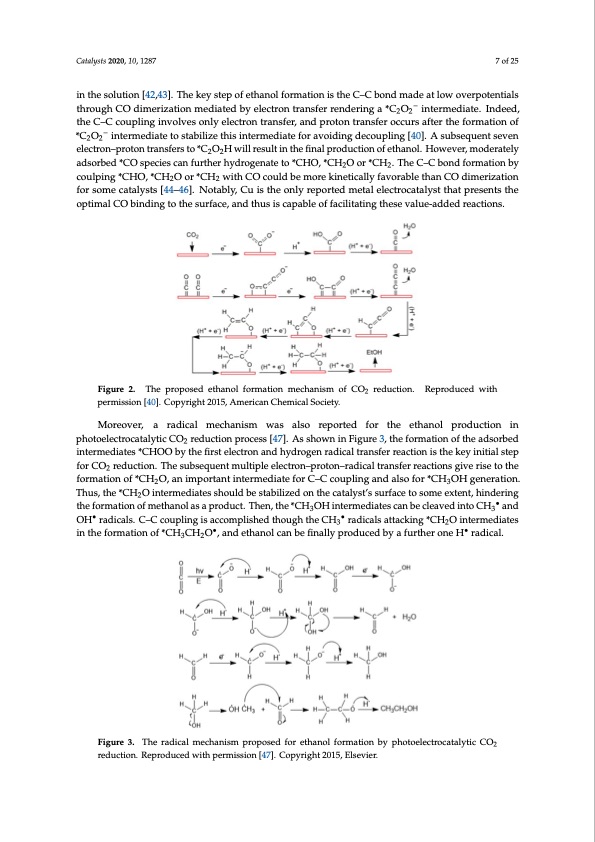
PDF Publication Title:
Text from PDF Page: 007
Catalysts 2020, 10, 1287 Catalysts 2020, 10, x FOR PEER REVIEW 7 of 25 7 of 25 Catalysts 2020, 10, x FOR PEER REVIEW instheCso–lCutbion[d42m,4a3d]e.TahtelokweyovsterpotfeentthialnsotlhfroorumgahtiConOisditmheeCriz–aCtiboonnmdemdaiadtedatblyoweleocvterropnotreanntsiafelsr is the C–C bond made at low overpotentials through CO dimerization media−ted by electron transfer − trhernoduegrhinCgOad*Cim2Oer2izianttieornmmedediaitaet.edInbdyeeedle,ctthroenCt–raCnscfoeurprleindgeirninvgolave*sCoOnlyienletecrtrmonedtiraatne.sfIenrd,eaend, rendering a *C2O2− intermediate. Indeed, the C–C coupling involves only electron transfer, and − tphreotCo–nCtrcaonuspfelirnogcicnuvroslvafetseronthlye efolercmtraotniotnraonfsf*eCr2,Oa2ndinptreormtoendtiratnestfoersotacbciulirzseatfhteirs tihnetefromrmedaitaitoenfofr proton− transfer occurs after the formation of *C2O2− intermediate to stabilize this intermediate for *aCvoOidinigndteercmouedpilaintegt[o40st]a.bAilsizuebstheqisuienntetrsmeveedniaetlecfotroanv–opirdoitnogndteraconusfpelrisngto[4*C0]2.OA2Hsuwbislelqreuseunltsinevtehne 22 avoiding decoupling [40]. A subsequent seven electron–proton transfers to *C2O2H will result in the efilnecatlropnro–dpuroctoionntroafnestfherasntol.*CHoOweHvweri,llmreosduelrtaintetlhyeafidnsoalrbperodd*uCcOtiosnpeocfietshcaannolf.uHrtohwerevheyrd, mroogdeneraatteeltyo 22 final production of ethanol. However, moderately adsorbed *CO species can further hydrogenate to a*CdsHoOrb,e*dC*HC2Osopre*cCieHs c2.aTnhfuerCth–eCr bhoynddrofgoernmataetiton*CbyHcOo,u*lCpHingO*CorH*OC,H*C.HT2hOe Cor–C*CbHo2nwd iftohrmCaOtioconubldy 22 *CHO, *CH2O or *CH2. The C–C bond formation by coulping *CHO, *CH2O or *CH2 with CO could cboeumlpoinregk*CinHetOic,a*lClyHfaOvoorrab*CleHthawnitChOCOdicmoeurlidzabteiomnofroerksionmeteiccaalltyalfyasvtsor[a4b4l–e4t6h].anNCotOabdlyim, Ceruiziastitohne 22 be more kinetically favorable than CO dimerization for some catalysts [44–46]. Notably, Cu is the fonrlysormepeocratetadlymstesta[l44e–le4c6t]r.ocNaotatlaybslty,thCautpisretshenotsnltyhereopotirmteadlmCOetablineldeicntgrotcoatahleysturthfactep,raensdenthtsutshies only reported metal electrocatalyst that presents the optimal CO binding to the surface, and thus is ocpaptiambalelCofOfabciinlidtaintigngtoththeesesuvraflauce-,aadnddedthruesacisticoanpsa.bleoffacilitatingthesevalue-addedreactions. capable of facilitating these value-added reactions. 22 7 of 25 Figure 2. The proposed ethanol formation mechanism of CO2 reduction. Reproduced with Figure 2. The proposed ethanol formation mechanism of CO2 reduction. Reproduced with Figure 2. The proposed ethanol formation mechanism of CO2 reduction. Reproduced with permission [40]. Copyright 2015, American Chemical Society. permission [40]. Copyright 2015, American Chemical Society. permission [40]. Copyright 2015, American Chemical Society. Moreover, a radical mechanism was also reported for the ethanol production in Moreover, a radical mechanism was also reported for the ethanol production in phottoellecttrroccaattaalylytticicCCOO2rerdeudcuticotniopnropcreoscse[s4s7][.4A7]s. sAhoswsnhoinwFnigiunreF3i,gtuhrefo3r,mthateiofnoormf tahteioandsofrbtehde 2 photoelectrocatalytic CO2 reduction process [47]. As shown in Figure 3, the formation of the iandtesormrbeediaitnetse*rCmHedOiOatebsy*tCheHfiOrOst eblyecthroenfiarnstdehlyecdtrognenanrdadhicyadlrtoragnesnferrardeiaccatliotrnainsstfheer kreaycitnioitniailsstehpe adsorbed intermediates *CHOO by the first electron and hydrogen radical transfer reaction is the fkoeryCOinitrieadlusctteipon.foTrheCsOu2bsreeqduuecnttiomnu.ltTiphleesluecbtsreoqnu–epnrottomnu–lrtaidpilcealetlreacntrsofenr–rperaocttoionn–sragdivicearlisteratonstfheer 2 key initial step for CO2 reduction. The subsequent multiple electron–proton–radical transfer froeramctaiotinosngoivfe*CriHseOto,athneimfoprmorattainontionfte*rCmHe2dOia,taenfoimrCpo–rCtacnotuipnltienrgmaenddiaatelsforfoCr–*CHcouOpHlinggenaenrdataiolsno. 23 reactions give rise to the formation of *CH2O, an important intermediate for C–C coupling and also Tfohru*sC, tHhe3O*CHHgeOneirnatteiromn.edTihautess, tsheou*CldHb2Oe sitnatbeirlimzedioantetshsehcoautaldlybste’sstsaubriflaiczedtoosnomthe ecxateanlyt,sht'sinsduerrfiancge 2 for *CH3OH generation. Thus, the *CH2O intermediates should be stabilized on the catalyst's surface thoesfomrmeaetxiotennot,fhminetdhearninoglatshaepforormduactti.onThoefnm,tehteh*aCnHol aOsHaipnrtoerdmucetd.iTatheesnc,atnhbee*CclHea3vOeHdiinttoerCmHedianteds 33 to some extent, hindering the formation of methanol as a product. Then, the *CH3OH intermediates ••••• OcaHn breadcliecavlse.dCi–nCtocoCuHp3linagnids OacHcomrapdlischaelsd. Cth–oCugchouthpelinCgHis arcacdoimcaplsliasthtaecdktihnogu*gChHthOe iCnHte3rmreadiactaels can be cleaved into CH3• and OH• radicals. C–C coupling is accomplished though the CH3• radicals ••• iantttahcekfinorgm*CatHio2nOoifn*tCerHmeCdHiatOes i,nanthdeeftohramnoatlicoannobfe*CfinHa3lClyHp2Orod, uanceddebthyaanfoulrctahnerboenfeinHallyrapdriocdaul.ced by a further one H• radical. 32 attacking *CH2O intermediates in the formation of *CH3CH2O•, and ethanol can be finally produced by a further one H• radical. Figure 3. The radical mechanism proposed for ethanol formation by photoelectrocatalytic CO Figure 3. The radical mechanism proposed for ethanol formation by photoelectrocatalytic CO22 Figure 3. The radical mechanism proposed for ethanol formation by photoelectrocatalytic CO2 reduction. Reproduced with permission [47]. Copyright 2015, Elsevier. reduction. Reproduced with permission [47]. Copyright 2015, Elsevier. reduction. Reproduced with permission [47]. Copyright 2015, Elsevier. 32 •PDF Image | Advances in Clean Fuel Ethanol Production from CO2 Reduction

PDF Search Title:
Advances in Clean Fuel Ethanol Production from CO2 ReductionOriginal File Name Searched:
catalysts-10-01287.pdfDIY PDF Search: Google It | Yahoo | Bing
NFT (Non Fungible Token): Buy our tech, design, development or system NFT and become part of our tech NFT network... More Info
IT XR Project Redstone NFT Available for Sale: NFT for high tech turbine design with one part 3D printed counter-rotating energy turbine. Be part of the future with this NFT. Can be bought and sold but only one design NFT exists. Royalties go to the developer (Infinity) to keep enhancing design and applications... More Info
Infinity Turbine IT XR Project Redstone Design: NFT for sale... NFT for high tech turbine design with one part 3D printed counter-rotating energy turbine. Includes all rights to this turbine design, including license for Fluid Handling Block I and II for the turbine assembly and housing. The NFT includes the blueprints (cad/cam), revenue streams, and all future development of the IT XR Project Redstone... More Info
Infinity Turbine ROT Radial Outflow Turbine 24 Design and Worldwide Rights: NFT for sale... NFT for the ROT 24 energy turbine. Be part of the future with this NFT. This design can be bought and sold but only one design NFT exists. You may manufacture the unit, or get the revenues from its sale from Infinity Turbine. Royalties go to the developer (Infinity) to keep enhancing design and applications... More Info
Infinity Supercritical CO2 10 Liter Extractor Design and Worldwide Rights: The Infinity Supercritical 10L CO2 extractor is for botanical oil extraction, which is rich in terpenes and can produce shelf ready full spectrum oil. With over 5 years of development, this industry leader mature extractor machine has been sold since 2015 and is part of many profitable businesses. The process can also be used for electrowinning, e-waste recycling, and lithium battery recycling, gold mining electronic wastes, precious metals. CO2 can also be used in a reverse fuel cell with nafion to make a gas-to-liquids fuel, such as methanol, ethanol and butanol or ethylene. Supercritical CO2 has also been used for treating nafion to make it more effective catalyst. This NFT is for the purchase of worldwide rights which includes the design. More Info
NFT (Non Fungible Token): Buy our tech, design, development or system NFT and become part of our tech NFT network... More Info
Infinity Turbine Products: Special for this month, any plans are $10,000 for complete Cad/Cam blueprints. License is for one build. Try before you buy a production license. May pay by Bitcoin or other Crypto. Products Page... More Info
| CONTACT TEL: 608-238-6001 Email: greg@infinityturbine.com | RSS | AMP |